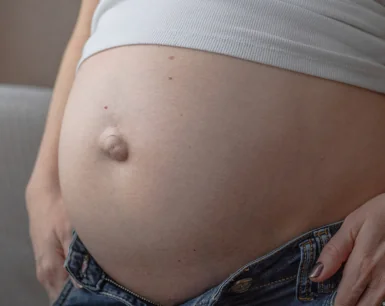If you’ve noticed a soft lump or swelling around your belly button that appears when you laugh, cough, or lift something heavy, you might be looking at an umbilical hernia. It’s one of those conditions many people brush off as “just a little bump”, but it deserves more attention than it usually gets.
Although umbilical hernias are common in babies, they can also appear later in life and in adults. Once developed in adults, they do not go away on their own.
So, what causes that bulge, when should you be concerned, and why is getting it sorted sooner rather than later such a wise decision?
What Is an Umbilical Hernia
An umbilical hernia develops when part of the intestine or fatty tissue pushes through a weak spot in the abdominal wall near the navel. This creates a small lump or swelling that often becomes more noticeable when standing, coughing, or straining, and usually flattens when lying down.
In babies, an umbilical hernia occurs when the small opening in the abdominal wall, where the umbilical cord passed through before birth, does not fully close. It is a relatively common finding in newborns, affecting around 1 in 5 babies in the UK, particularly among those born prematurely or with a lower birth weight. In most cases, it is harmless and many of these tend to resolve naturally by the age of four or five.
In adults, umbilical hernias develop for different reasons. The abdominal muscles gradually weaken over time, and anything that increases pressure inside the abdomen can cause tissue to push through. Pregnancy, obesity, repeated heavy lifting, and chronic coughing are recognised risk factors, with research showing that over half of adult cases are linked to raised abdominal pressure. Umbilical hernias are also more common in women who have had multiple pregnancies and in people who experience long-term abdominal strain.
Why They Happen
Anything that increases internal abdominal pressure can push tissue through weakened muscles. Carrying excess weight, ongoing constipation, or even a lingering smoker’s cough can all contribute. Over time, the strain stretches the tissues around the navel, allowing a small pocket of intestine or fat to protrude.
It’s rarely dramatic at first, just a soft bump that comes and goes, but over time it can enlarge and cause discomfort.
How to Spot the Symptoms of Umbilical Hernia
The main sign of an umbilical hernia is a round lump or swelling near your belly button. It may come with a dull ache, a feeling of pressure, or mild discomfort when you strain, lift, or stand for long periods.
In babies, the bulge often becomes more noticeable when they cry or strain, but it rarely causes pain and usually settles naturally. In adults, however, the lump can gradually become larger and firmer, especially after meals or physical activity.
Occasionally, part of the intestine can become trapped inside the hernia, a situation known as incarceration. If the blood supply to that trapped tissue is cut off, it becomes a strangulated hernia, which is a medical emergency. Symptoms such as sudden, severe pain, nausea, or a lump that turns red or hard mean you should seek urgent medical help straight away.
Do Umbilical Hernias Always Need Surgery
In children, most umbilical hernias heal on their own within a few years. Surgery is only needed if the hernia persists beyond age five, grows unusually large, or causes pain.
In adults, however, hernias won’t close naturally. Surgery is the only way to repair the muscle wall and prevent complications. The procedure is safe, simple, and carried out under general anaesthetic. The surgeon gently pushes the tissue back into place and strengthens the weak spot with stitches or mesh.
Two main methods are used: open surgery, which involves a small incision near the navel, and keyhole (laparoscopic) surgery, where tiny cuts are made for a camera guided repair. Both techniques have excellent results, and most people return home the same day.
Living with an Umbilical Hernia
If your hernia is not painful or causing any problems, your GP may recommend keeping an eye on it for a while. However, a few lifestyle changes can make you more comfortable. Maintaining a healthy weight reduces pressure on the abdomen, while eating a fibre-rich diet and drinking plenty of water can help prevent constipation. Avoiding heavy lifting and doing gentle core-strengthening exercises such as yoga or swimming can also make a difference.
Even so, these measures only help to manage the symptoms; they do not repair the hernia itself. Over time, many people find that hernia surgery provides the most effective and lasting solution, offering both relief and peace of mind.
Why Choose Private Hernia Treatment in the UK
While the NHS offers excellent surgical care, waiting times for hernia repair can be long. Living with discomfort or uncertainty can make daily life difficult, and delaying treatment may allow the hernia to worsen.
At Phoenix Health, you don’t have to wait. Our private hernia repair service offers rapid access to leading British consultant surgeons who specialise in minimally invasive hernia procedures. From your first consultation to recovery, you’ll receive personal care, clear guidance, and expert support throughout.
With no NHS waiting list, you can book a consultation at a time that suits you, have your surgery promptly, and get back to normal life much sooner. To arrange a consultation with one of our specialist surgeons, call Phoenix Health on 01244 738 159. Our friendly team will guide you through your options and schedule an appointment without delay.
Medically Reviewed by Mr. Qutayba Almerie, MD, MSc, FRCS
Consultant Upper GI & Bariatric Surgeon, Medical Director at Phoenix Health.
Enquiry Form




